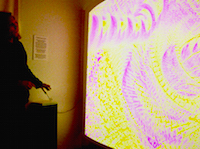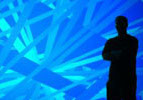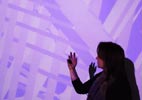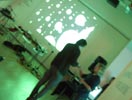The CubeLife project
The CubeLife website and subdomains are home for research and artwork based on magic matrices since the mid-90s. The two main facets are CubeLife (interactive heartbeat-driven artwork) and the Magic Square Webapp (beta version online) for scalable resolution-independent patterns and exhibitable animated SVGs based on magic square visualisations.
CubeLife continues to develop in multiple ways:
- an interactive/performance heartbeat-driven visual and sonic artwork
- a cultural investigation into integer patterns
- a range of investigative research tools
- a generator and repository for magic square patterns
Magic square pattern generator (see galleries)
Research into magic square patterns (separate from magic cubes) is now focussed on a Magic Square Webapp that enables the magic line to be drawn in various ways, and calculates many other properties we (myself and my wife Fania) are using to analyse magic square categories. Our paper on this research is published in the proceedings of the Computer Arts Society conference EVA (Electronic Visualisation and the Arts)—see the presentation slides from EVA 2020, and the presentation to the Computer Arts Society ealier in 2020. View a brief video of one animation.
Heartbeat-driven artwork
(1) is an interactive, exhibitable installation and internet-resident artwork. It contains a virtual world populated by magic cubes (one kind of magic matrix in 3 dimensions), each created as pulsing patterns by participant input in the exhibition space via a heartbeat sensor. Each cube has an associated sound, and a finite life.
CubeLife 1 (image, top left) began in 1998 as a collaboration between artist/coder Dave Everitt and interaction designer/programmer Greg Turner while at Loughborough University Human-Computer Interface department. It was first exhibited at bioMatrix in September 1999 at the Loughborough School of Art gallery, with support from the former Gallery of the Future. This work evolved over time into a larger, more encompassing project, outlined by this website.
CubeLife 2 from around 2010 (images, top right) added online input (no longer available) and an artificial life environment where cubes can be made to flock with other cubes or follow various defined behaviours. Colours and other variations can either be chosen by an inbuilt colour harmony system, or pre-programmed for particular effects. When the original heartbeat sensor failed (infra-red clip), it was adapted to take input from hand-grip sensors. See some CubeLife still shots or Download a PDF of the cubeLife gallery information sheet. Exhibitions/performances:
- DMU Cube Gallery 9—22 Apr 2011, at Leicester's Phoenix Square.
- performance at the Live Electronics concert MTI, 24 Nov 2010, Phoenix Square Screen Lounge
- "We Are Here", Q Arts Gallery, Derby, Feb 2007
There is no hierarchical structure to this site apart from the main menu. Text links burrow into deeper information.



